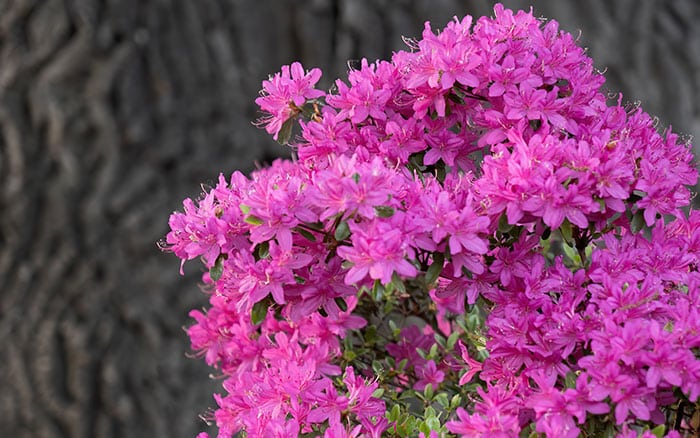Incredibly popular flowering plants, there are so many rhododendrons to choose from to suit your garden space and style. For smaller varieties to grow in containers to larger shrubs for big gardens. Find out more about how to grow rhododendrons in your garden with these tips.
Growing rhododendrons
Rhododendrons are fully hardy ornamentals that can survive temperatures as low as -30°C.
They flower so profusely that the branches become obscured by a profusion of beautiful flowers.
They come in an array of shades, producing great blocks of colour in the garden that will last throughout spring.

Planting rhododendrons

Rhododendrons prefer acidic soil and sheltered conditions, and they grow best in areas with high rainfall. Also, they will happily grow in raised beds. However, it’s important not to plant them too deep – the top of the root ball should be level with the ground’s surface, or even an inch or two above it.
Compact hybrid varieties can also be planted in containers, whilst dwarf alpines are suitable for rock gardens.
Other species include azaleas, which are often used as hedges or around foundations. Also, many larger-leafed rhododendrons lend themselves well to informal planting and woodland gardens.
Bear in mind that rhododendrons need neutral to acidic soil, so only plant in the garden if your soil is suitable.
You can check this using pH testing kits from a garden centre. Although, if you have alkaline soil, you can use ericaceous compost suitable for rhododendrons and azaleas and plant up in containers.
Take care
To care for the plants best, give them an annual mulch with ericaceous compost or bark chippings. Alternatively, for container grown types, remove the top layer of soil and replace it with fresh ericaceous compost, or repot if necessary with fresh compost.
In addition, watering with rainwater when possible can be beneficial because tap water could contain too high levels of calcium.
Pruning rhododendrons isn’t hard work. Instead deadhead any dead flowers to keep the shrub looking fresh and attractive.

Types to try
Rhododendron ‘Nancy Evans’
First is an evergreen variety that has cheery golden yellow flowers that bloom in spring from orange-red buds. The compact habit makes is great to grow in containers for a low maintenance but highly attractive addition too.
- Flowers in spring
- Hardy
- Grows to 1.5m tall and wide
- Moist but well-drained
- Partial shade
- Sheltered

Rhododendron ‘Orakel’
The exotic purple blooms of ‘Orakel’ are sure to be a showstopper in your garden from spring to summer. Not only can you appreciate the blooms but they are popular with pollinators too. Keep protected from harsh winter winds and they will grow happily.
- Flowers in spring
- Fully hardy
- Grows to 1m tall and 2.5m wide
- Moist but well-drained
- Partial shade
- Sheltered

Rhododendron ‘Praecox’
Finally, this small variety grows to 1.2m and has oval, dark, glossy leaves that are joined by delicate looking pink-purple flowers in late winter. ‘Praecox’ is an early flowering variety that will look great in many garden styles, including courtyard and city gardens to cottage and informal spaces for a low maintenance pick.
- Flowers in winter
- Fully hardy
- Grows to 1.5m tall and wide
- Moist but well-drained
- Full sun or partial shade
- Sheltered


Leave A Comment